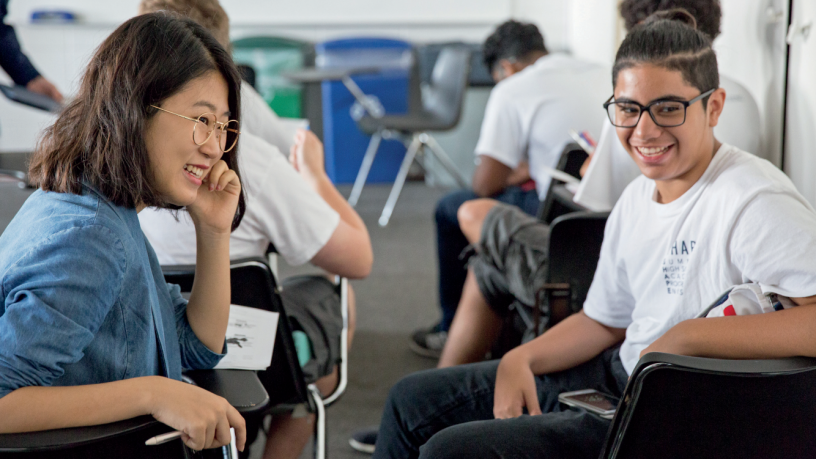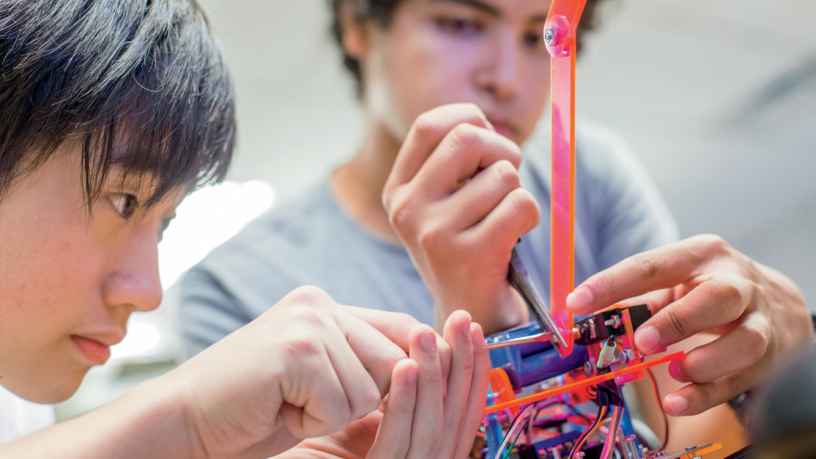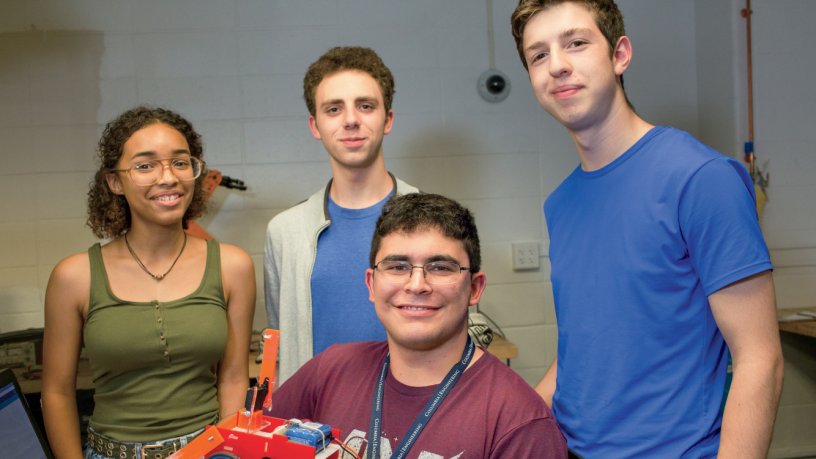Taking Shape
Some students at SEAS this July and August looked a little younger than usual, thanks to Columbia Engineering’s new Summer High School Academic Program for Engineers (SHAPE). The selective program offered two intensive three-week sessions of college-level courses in robotics and computer science led by Columbia faculty, in addition to electives in entrepreneurship and research skills led by postdocs and students.

Tianyu (Carol) Shao (left) and Juan Neira in the College Prep workshop. (Photo by Timothy Lee Photographers)

Two students tackling a project for Introduction to Robotics

DeAnna Lizardo, Levi Olevsky, David Zaretsky, and Kevin Gauld—aka Team Barbershop—with their robot, the “Mystery Muffin”.

Computer Science students polish a game design for their final presentation. (All photos by Timothy Lee Photographers).
“SHAPE is an exciting new way for Columbia Engineering to connect with local high school students,” said Emily Ford, director of outreach programs and special projects at SEAS. “It’s a chance to learn directly from college professors, sit in actual college classrooms, and get to know current engineering students. There’s no better way to get a real feel of what college is like and what it’s like to be a student at Columbia Engineering.”
Participants—74 rising high school sophomores, juniors, and seniors mostly from New York, New Jersey, and Connecticut—chose between an introduction to robotics and a primer on computer science. The robotics course, taught by Mechanical Engineering Lecturer Sinisa Vukelic, focuses on conceiving and fabricating toy robots capable of executing posed tasks within a maze—such as detecting a candle and extinguishing the flame—to impart principles of mechanical design, sensor technology, and locomotion. The computer science course, co-taught by Lecturers Daniel Bauer and Ansaf Salleb-Aouissi, is a general introduction to computational thinking including algorithmic problemsolving, programming in Python, and designing variations on the classic game Minesweeper.
Linda Chen, a rising junior from the Dwight-Englewood School in Bergen County, New Jersey, built a robot called Yonalice (named after two undergraduate mentors) alongside teammates Rishi Kinsara of McNair Academic High School in Jersey City, New Jersey, and Mir Shadman Alam of Manhasset High School on Long Island.
“This is a really nice opportunity to be more ‘hands-on’ and build,” Chen said, as she worked on the robot. “We’re expected to learn through our mistakes— it’s better than a lecture.”
SHAPE students also chose between electives examining entrepreneurship and research skills. The entrepreneurship elective fostered student innovation for tech, while the research skills elective oriented students to the research environment, from lab culture to writing research papers. Participants logged extensive time in the school’s MakerSpace and Mech-Tech labs, which feature 3D printers and a laser cutter among much other equipment, and on field trips exploring different branches of engineering, in addition to attending several college prep workshops. The group visited and toured the Newtown Creek Wastewater Treatment Plant to learn about environmental and civil engineering, followed by a presentation by Professor Kartik Chandran on resource recovery. The program has also visited a number of labs on campus, especially highlighting the cutting-edge electrical and chemical engineering research of Professors Allie Obermeyer and Christine Hendon.
“What we did in three weeks [at SHAPE], I did in two years [at school],” said Levi Olevsky, a rising senior at Stuyvesant High School in New York City, about SHAPE’s accelerated curricula.
Several SEAS undergraduate mentors played an important role in the program—offering support to faculty instructors as well as supervision over participants’ group projects, leading field trips, guiding their protégés around campus, and encouraging budding young STEM talent to take their interests to the next level. “
“I was very excited for the opportunity to give back directly and help inspire high schoolers to pursue engineering,” said Kristen Wang ’18, one of the mentors. “Doing a similar program helped get me interested in computer science.”
